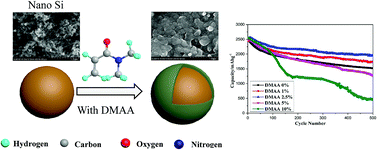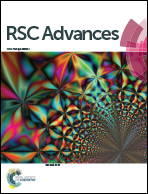Dimethylacrylamide, a novel electrolyte additive, can improve the electrochemical performances of silicon anodes in lithium-ion batteries
Abstract
To enhance the electrochemical properties of silicon anodes in lithium-ion batteries, dimethylacrylamide (DMAA) was selected as a novel electrolyte additive. The addition of 2.5 wt% DMAA to 1.0 M LiPF6/EC : DMC : DEC : FEC (3 : 3 : 3 : 1 weight ratio) electrolyte significantly enhanced the electrochemical properties of the silicon anode including the first coulombic efficiency, rate performance and cycle performance. The solid electrolyte interphase (SEI) layers developed on the silicon anode in different electrolytes were investigated by a combination of electrochemical and spectroscopic studies. The improved electrochemical performances of the Si anode were ascribed to the effective passivation of DMAA on the silicon anode. The addition of DMAA helped develop a uniform SEI layer, which prevented side reactions at the interface of silicon and electrolyte.



 Please wait while we load your content...
Please wait while we load your content...